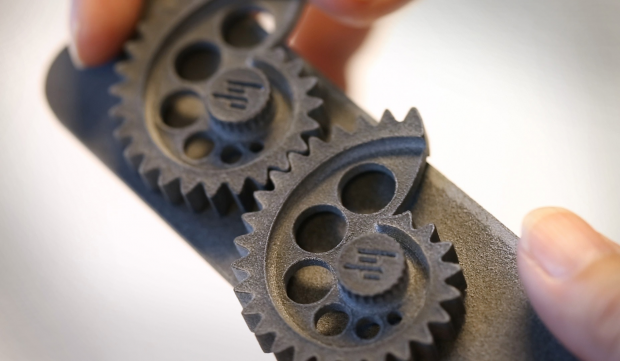Jabil Sees the Future of Manufacturing

With HP Jet Fusion 3D printing technology, you can create what was once a piece-part product as a single printed object. Image courtesy of HP Development Co LP.
Latest News
September 19, 2017
If you rode to 1997 in Mr. Peabody’s WABAC machine, you’d hear the punditry back then breathlessly touting 3D printers as traditional manufacturing’s latest replacement. To borrow what a lead manufacturing engineer with years of experience with most additive manufacturing technologies says in today’s Check It Out offering, 3D printing has often been “ripe for hype.” But then he says that the 3D print technology he’s using now is “really new and it’s very strategic, and we see it having a significant impact.“
And he’s the more skeptical of the two engineers who share their real-world experiences with HP’s Jet Fusion multi-jet 3D printer in “Jabil Sees the Future of Manufacturing with HP 3D Printing.” This presentation offers a quick minute-forty video and a short read. It could disrupt your impression of 3D printing and leave you taking another look at your manufacturing processes. So, what’s going on here?
 With HP Jet Fusion 3D printing technology, you can create what was once a piece-part product as a single printed object. Image courtesy of HP Development Co LP.
With HP Jet Fusion 3D printing technology, you can create what was once a piece-part product as a single printed object. Image courtesy of HP Development Co LP.Backdrop: Jabil is a big-league consumer manufacturing solutions provider. It runs more than 15,000 CNC machines and huge numbers of molding machines at over 100 facilities in 28 countries. It also operates most every 3D printing technology you’ve heard of plus some. At a site in California, two HP Jet Fusion 3D printers came online. Apparently, they’ve blown away the VP of digital manufacturing and the lead manufacturing engineer.
Why? Well, there’s the hands-on, practical level and then the potential level. On the hands-on side, they cite speed, big build envelope and semi-automatic material handling that ensures part consistency across runs of various sizes. Its part quality competes with traditional manufacturing processes. They’re impressed that they can “essentially flip a switch” from prototype to build an end-use part on the same unit. They call out its ability to make piece-part products as a single printed object, eliminating secondary processes like assembly. It saves time and money.
But it’s the technology’s potential that they call a game changer. It’s like the early days of desktop PCs: It’s a tool they’re still learning to use, but they can see how it enables the imagination to create things never created before. Engineers are generally too gruff to use words like “the next renaissance in manufacturing” as one says here. That they do should make an impression on you.
Hit today’s Check it Out link to watch and read “Jabil Sees the Future of Manufacturing with HP 3D Printing.” Well worth your time.
Thanks, Pal. – Lockwood
Anthony J. Lockwood
Editor at Large, DE
Subscribe to our FREE magazine, FREE email newsletters or both!
Latest News
About the Author
Anthony J. Lockwood is Digital Engineering’s founding editor. He is now retired. Contact him via [email protected].
Follow DE







 Dear DE Reader:
Dear DE Reader: